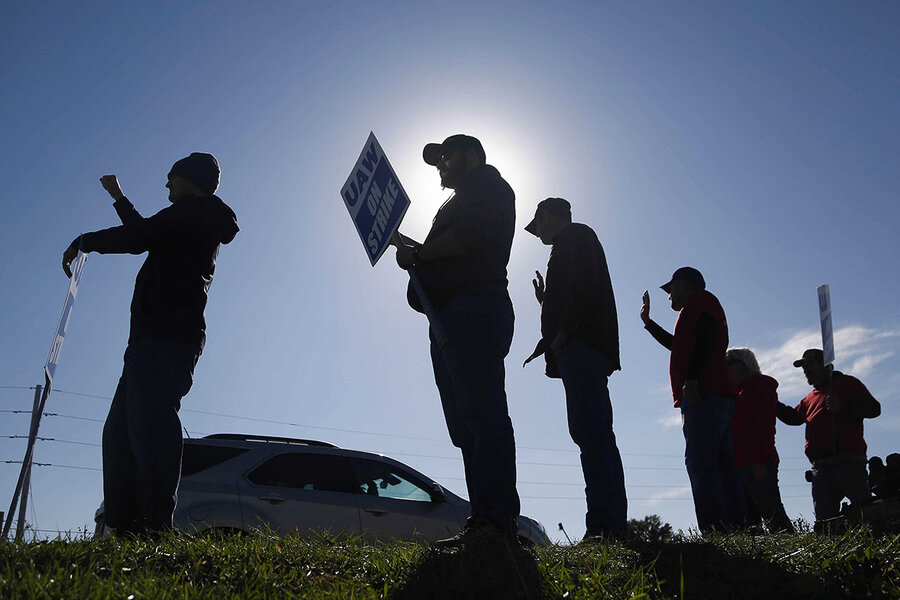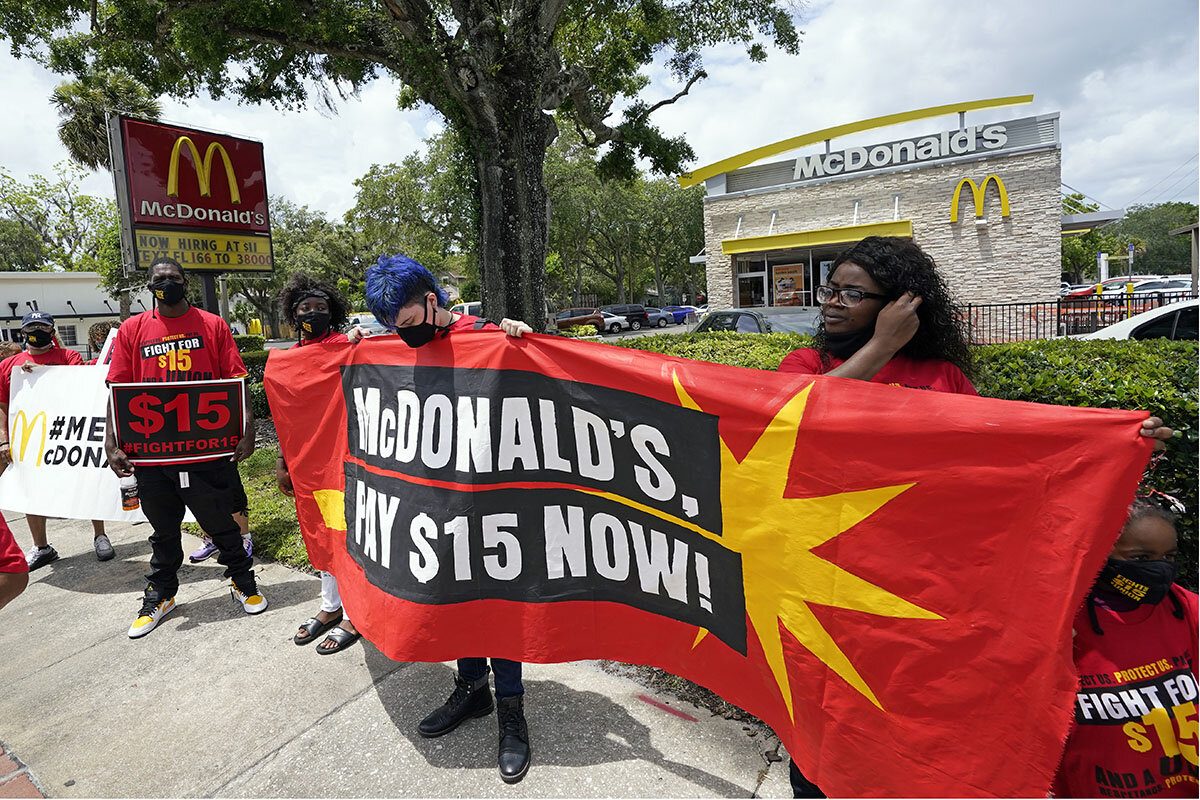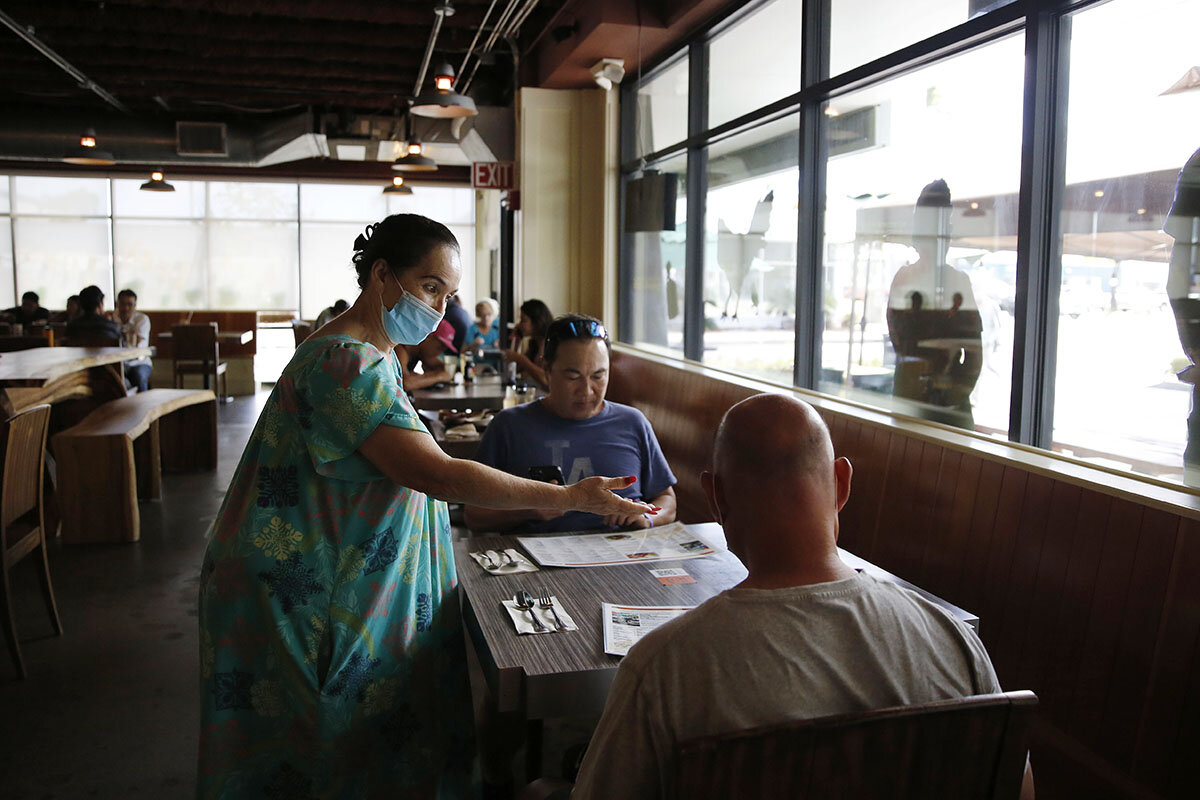For workers, labor shortage means new leverage – and higher pay
Loading...
Suddenly, labor has leverage over management. Workers are in such short supply that there are 2 million more job openings than unemployed Americans. That’s allowing employees to be choosier about picking a job and tougher in negotiating higher pay.
John Deere has just offered its striking workers a 10% wage boost, double the percentage of its first contract proposal. Just last week, warehouse club Costco began boosting pay to a minimum $17 per hour. Coffee chain Starbucks said it would raise minimum wages to $15 an hour next summer. All this is good news for employees, especially those at the bottom of the income chain.
Why We Wrote This
As employers confront a labor shortage, working Americans have new leverage to bargain for pay, benefits, and flexibility. One analyst says, “Is it a labor shortage or is it a wage shortage? There’s a solution for this.”
In the short run this contributes to a bout of inflation in consumer prices. Longer term, some analysts see trends such as baby boomer retirements and declining fertility creating a permanently smaller workforce. That could suggest ongoing worker shortages, chronic inflation, and reduced economic growth. Others say the labor force can grow dramatically as fears about COVID-19 recede and higher wages lure more people back to employment.
“I’m in the optimist camp,” Julia Coronado, founder of the research firm MacroPolicy Perspectives, said at a webinar last week. “The labor market is incredibly flexible.”
Perhaps not since Johnny Paycheck belted out his 1977 hit – “Take This Job and Shove It” – has worker discontent been so front and center in the American consciousness.
The nation’s quit rate – the share of workers voluntarily leaving their jobs – hit a record 2.9% in August. Microsoft predicts 41% of workers globally are considering leaving their employers. A recent Harris Poll finds that half of workers in the United States want to make a career change.
In a sign of the new combativeness, the AFL-CIO labor federation last month put up a map on its website, showing nearly 30 locations where strikes are underway, from big employers like Kellogg and John Deere to the 75 musicians picketing the San Antonio Symphony.
Why We Wrote This
As employers confront a labor shortage, working Americans have new leverage to bargain for pay, benefits, and flexibility. One analyst says, “Is it a labor shortage or is it a wage shortage? There’s a solution for this.”
The frustration isn’t limited to union workers. In 12 cities last month, hundreds of McDonald’s employees walked off the job to protest sexual harassment in the workplace. Netflix recently fired an employee who was organizing a walkout over the company’s airing of comedian Dave Chappelle’s special, which gay and transgender people have found highly objectionable.
Some have dubbed this worker revolt the Great Resignation; others, Striketober. The idea is that the worker shortage has swung leverage from companies to workers and hit a reset button on 40 years of rising corporate power.
“We’ve never seen levels of discontent with work the way we’re seeing today,” says Toby Higbie, a professor of history and labor studies at the University of California in Los Angeles.
Reasons for the gap
While many workers are fed up with their current or former employer – or at least now feel the freedom to express it – there are other reasons unemployed Americans haven’t flocked back more quickly to the factory floor, the cashier line, and the office cubicle. One factor is the pandemic itself, which has scared off many from returning to work. Others have used this time to re-imagine their work lives and are prioritizing new careers or even goals outside of work, such as spending more time with family. Then there’s the mismatch between jobs workers had been doing, which no longer exist, and the positions that employers are now offering.
“There really is no labor shortage,” says Alí Bustamante, deputy director of the Education, Jobs, and Worker Power program at the Roosevelt Institute. “When you see the evidence that there’s over 5 million jobs missing from the economy relative to February prior to the pandemic, I think what you’re actually seeing is there’s a considerable amount of displaced workers whose jobs haven’t returned.”
Some of the industries that lost the most jobs as the pandemic began are also the ones that are having a hard time filling open positions: frontline occupations requiring extensive contact with people. Examples include leisure and hospitality, education services, and local government. Those jobs may be perceived as more dangerous during the pandemic.
Undoubtedly, some laid-off workers used extra federal unemployment benefits to avoid work. But that does not appear to have been much of a factor in the Great Resignation, said Gregory Daco, chief U.S. economist for Oxford Economics in New York, speaking at a recent webinar sponsored by the National Association for Business Economics (NABE). In any case, those extra benefits expired by September.
More important are long-term social and demographic trends, such as the retirement of baby boomers, the ongoing challenges for working mothers searching for child care, the declining labor participation of men, and the fall in fertility and immigration. Most of these trends were exacerbated by the pandemic; all of them predate it.
Rising leverage
These trends give those in the labor force added power. With 2 million more job openings than unemployed people, Americans can be choosier about picking a job. They have more leverage to request higher pay and better hours. Wages have begun to rise, starting with the lowest-paid employees and now spreading throughout the economy.
For employers, used to having the upper hand for most of the past 40 years, the Great Resignation is demanding a rethinking of employee relations. According to an outline released Sunday, Deere is offering to boost wages 10%, double its last contract proposal, and to keep a pension program for new hires that it originally planned to drop.
Permanent problem or a passing phase?
Economists are divided over whether these trends mean a permanently smaller workforce – and thus continued worker shortages and inflation – or whether they will be reversed by a growing labor force that will staff most of those open positions. Emsi, a labor market data company with headquarters in Boston and Moscow, Idaho, has dubbed this era the beginning of a “sansdemic” – a future where the U.S. won’t have enough workers and thus will see reduced growth.
“I’m in the optimist camp,” Julia Coronado, founder and president of New York research firm MacroPolicy Perspectives, countered at the NABE webinar. “The labor market is incredibly flexible.”
For example, during the pandemic, Oxford Economics estimates that the labor force lost an extra 2.5 million to 2.7 million boomers over and above the normal retirement rate. But much of that shortfall did not come from a slew of extra retirements; it came because the normal flow of retired boomers who typically reenter the labor force dried up during the pandemic. If coronavirus caseloads continue to fall, it’s not unreasonable to think that those retirees will feel safe reentering the workforce, Ms. Coronado says.
It’s not just retirees who may return. New research suggests that there is a shadow workforce, and that for every drop of 1 percentage point in the unemployment rate, there is a rise of two-thirds of a point in the size of the labor force. Workers who had quit looking for jobs during a recession begin looking again. But there’s a lag. Unemployment has to fall considerably before the labor force begins to grow again. If the pattern of previous recessions holds true this time, the growth in the labor force should begin quite soon, Ms. Coronado says, because the unemployment rate fell below 5% in September.
“There’s a solution for this”
Over time, that should diminish workers’ leverage and ease wage increases. And as long as productivity growth remains strong, inflation should also stay in check. While workers will be paid more per hour, they’ll also be producing more per hour.
For the moment, power rests with workers. Wages are starting to rise throughout the economy, says Mr. Daco of Oxford Economics. Just last week, warehouse club Costco started to boost pay to a minimum $17 per hour. Coffee chain Starbucks said it would raise minimum wages to $15 an hour next summer.
In restaurants, one of the industries hardest hit by the pandemic, wages are rising at double the rate for workers overall, says Hudson Riehle, senior vice president for research at the National Restaurant Association in Washington. For the leisure and hospitality sector as a whole, which includes restaurant workers, they’ve risen a record 7.4% over the past year.
To cope, restaurateurs are boosting menu prices, increasing curbside takeout and delivery options (which tend to generate more revenue per worker than a traditional server), and incorporating new technology such as digital menus and online ordering. Some are farming out their delivery to so-called ghost kitchens – central commissaries that prepare and deliver food for one or many restaurants.
By itself, such automation is unlikely to end the worker shortage anytime soon. Nevertheless, a more efficient and better-paid workplace may be just the ticket to lure jobless people back from the unemployment rolls.
“Open up any newspaper today, [you see] the labor shortage, the labor shortage, the labor shortage!” says Andrew Schrank, a professor of international and public affairs at Brown University in Providence, Rhode Island. “Is it a labor shortage or is it a wage shortage? There’s a solution for this.”











